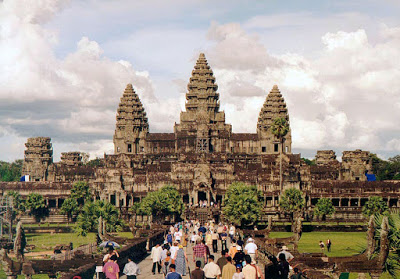Angkor Wat, the temple complex located in Siem Reap province, Cambodia, is the largest religious monument in the world. Its name translates to City of Temples in the Khmer language. The word ‘Angkor,’ meaning city, was derived from the Bengali word Nokor Wat meaning temple grounds. An amazing example of the Khmer architecture, the temple complex was built by the Khmer King Suryavarman II in the early 12th century. It was built as a Hindu and later went on to be converted into a Buddhist temple. Suryavarman conceived it as his state temple and the eventual mausoleum
Angkor Wat is dedicated to god Vishnu, a fact that marks a departure from the tradition of Khmer kings, who used to follow the Shaiva traditions. The edifice is a national symbol of Cambodia and is featured in the national flag of the country.
Angkor Wat
Legend has it that a Hindu god, Indra, constructed Angkor Wat as a palace for his son Precha Ket Mealea. The construction began during the reign of King Suryavarman II, who ruled till his death in 1150. Most of the works had finished by the time of his death. Later, the enemies of the Khmers attacked and sacked the city. Later a new king named Jayavarman VII restored the empire. He built a new capital and state temple further away from the temple. They are called Angkor Thom and Bayon temple.
In the following years, Angkor Wat gradually converted to a Buddhist temple. From the 14th century, it was occupied by Buddhist monks.
After the 16th century, the temple was more or less abandoned and overgrown with vegetation. In the 19th century, Henri Mouhot, a French naturalist and explorer, was the one who re-discovered the temple and popularized it in the western world. The temple underwent considerable restoration works in the 20th century, often interrupted by the revolts in Cambodia.
The temple compound extends to over more than 500 acres. It is surrounded by a moat with a perimeter of 5.5 kilometers. The temple itself is an example of magnificent architecture and amazing sculpture. The central tower of the temple is 65 meters high and is surrounded by four smaller towers. The architecture is modeled after the mythological peak of Mount Meru.
This historical largest religious monument was almost insignificant to political or cultural ministries of the country till the 13th century. However, as it held great importance in Buddhism, it remained an architectural marvel that kept attracting visitors and tourists. The significance of this religious monument increases many folds since it is built of Mount Meru, which, according to Hinduism and Buddhism, is the home of their gods.
This religious monument has endured numerous upheavals – from earthquakes to invasions and from restoration projects to several attempts at stopping such projects. The outer walls of the temple were made out of sandstone, while the rest of the structure entails mainly woodworks. Hence, Angkor Wat could not be preserved fully. However, it is still one of the majestic buildings around the world, with its highest tower on top of the shrine reaching about 70 feet in the air.
It is covered with countless sculptural decorations. They feature many scenes from Hindu epics Ramayana and Mahabharata and a large number of deities. The temple is now a UNESCO World Heritage Site and a famous tourism destination. More than a million people visit the great architectural wonder every year.
Since 1993, a committee called the International Coordinating Committee for the Safeguarding and Development of the historic site of Angkor (ICC-Angkor) looks after the scientific restoration, and conservational projects that are Cambodian government carries out.
You might also like:

